Ijraset Journal For Research in Applied Science and Engineering Technology
- Home / Ijraset
- On This Page
- Abstract
- Introduction
- Conclusion
- References
- Copyright
Forecasting with Erratic Ingredient Transformation
Authors: V. Mohana Priya, U. Ruchitha, Mrs. S. P. Audline Beena, Dr. D. Rajinigirinath
DOI Link: https://doi.org/10.22214/ijraset.2023.51923
Certificate: View Certificate
Abstract
In this paper, we acquire the objectives of the clients and ascertain the prospects for appropriate strategies for them based on the way they approach proposals. Here, we have proposed a feasible proposal for approaching the demands of the customers and delivering to them. In our proposal, in the field of Machine Learning, we have been able to achieve an accurate results by using Logistic Regression. This enables us to provide a better solution while manipulating the request and satisfying the customer\'s requirements. Logistic regression is a Machine Learning classification algorithm that is used to predict the probability of certain classes based on some dependent variables. Supervised learning is the types of machine learning in which machines are trained using well labelled training data, and on basis of that data, machines predict the output. It is used for predicting the categorical dependent variable using a given set of independent variables. Logistic regression in our model of approach which used to predicts the output of a categorical dependent variable. As part of our proposed model for this project, we propose that we develop a natural dye and pigment that is biodegradable, non-toxic, and allergy-free that contains fewer inorganic substances, and then we will make research-based inorganic pigments. It is possible that with our proposal we will be able to satisfy all customer requirements, We use a logistic regression algorithm to determine whether or not. They have a far lower environmental effect than synthetic dyes, provided that they are treated in a way that eliminates the use of hazardous chemicals throughout the dyeing and finishing process.
Introduction
I. INTRODUCTION
The objectives of the clients are obtained in this proposal, and based on how they approach proposals, we determine the prospects for suitable tactics for them. In this article, we've put up a workable plan for meeting client requests and delivering on them. We were able to produce reliable results for our Machine Learning project by utilizing Logistic Regression. As a result, we are able to manipulate the request and meet the needs of the consumer while offering a superior solution. Based on some dependent variables, the machine learning classification process known as logistic regression is used to forecast the likelihood of a given class.
Machines are educated using properly labelled training data, and then utilizing that data to predict the outcome, is known as supervised learning. With a predetermined set of independent factors, it is used to predict the categorical dependent variable. In our model of methodology, we employed logistic regression to forecast the results of a categorical dependent variable. In our concept for this project, we suggest developing a natural dye and pigment that is biodegradable, non-toxic, allergy-free, and includes fewer inorganic materials, and then producing inorganic pigments based on research. We employ a logistic regression model to analyse whether or not we can satisfy all customer needs with our proposal. If they are handled in a way that prevents the use of dangerous chemicals during the dyeing and finishing processes, they have a much lower environmental impact than synthetic colours. With the advanced logistic regression technique, we are finding many ways to satisfy the rationale. For better results in analysing the client's demands and requirements, our proposed model in machine learning technique uses the logistic regression algorithm. It may also examine the feasibility and have a report with a sample model. When the dye production process is complete, it is processed in our research area, where the pH level and soaking temperature are two of the criteria used to evaluate it and employ a variety of testing methods to provide the best solution.
II. EXISTING SYSTEM
In the dye and pigment manufacturing sector, mostly inorganic chemicals were used in dyes and pigments to produce it. Minerals and salts are used to create inorganic pigments, which are based on combinations of oxide, sulphate, sulphide, carbonate, and other similar elements, it may also in opaque and mostly seemingly unsolvable based on their affordable pricing and great demand in the industrial sector, manufacturing businesses also make inorganic dyes and pigments. Inorganic pigments often maintain color well, but the color they make on their own is frequently drab and some are even overtly hazardous, like lead-based pigments.
III. PROPOSED SYSTEM
It is our proposal to convert inorganic dyes into organic dyes by using the methods we describe in this proposal in order to achieve the desired result, generally natural colors are safe for use, non-allergenic, and biodegradable. As long as they are given in a way that completely forgoes the use of dangerous chemicals throughout the dyeing and finishing process, they have a far smaller impact on the environment than synthetic dye. Our model has objective to assess the client's demands and decide whether it is possible or not the dye product based on organic and inorganic components can be produced. We are satisfying the logic with the sophisticated logistic regression algorithm in different approaches. Our proposed model in machine learning technique using logistic regression algorithm for better results in analyze the client needs of requirement, it may checks the possibility and having the report with sample model. The dye production process is finished then it will process in our research area and the pH level with soaking temperature are two of the parameters that are used to assess it thereby utilizing the numerous testing techniques, which makes the better solution in the final product. In our model of approach we will get the requirement with trained data and get the analysis report possibility or not. We would compare both organic and inorganic dyes and also provide reports on their benefits and disadvantages. The client would then select whether to use organic or inorganic colors for the better results.
IV. ARCHITECTURE DIAGRAM
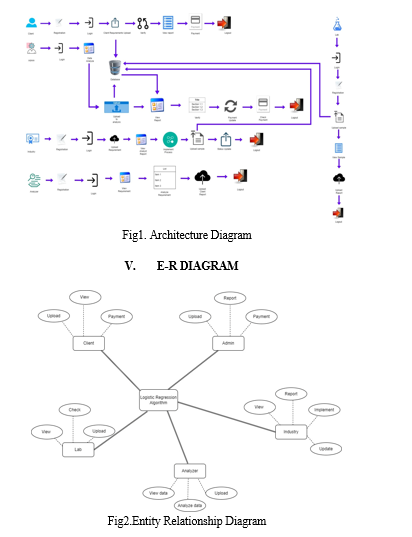
VI. MODULE DESCRIPTION
A. Module 1 : Client
In this module the client wants to register and login in this module, it will redirect to the client homepage which include upload, registration, test details, status report, will displayed on the client homepage. The admin will review the client registration details. Client can view their registration details on the view status page. Once get the approval from admin it will show on the view status page. Then the client will upload the requirement details on the upload page. Before upload the requirements id processing is compulsory. The id will be send to the client email id. After entering the id then it will be allow to upload the requirements. After successfully upload the requirements to the admin. Client will request the report from the analyzer which is possible or not to process the data. The analyzer will send the requirement data report to the client. The client will get the report from the analyzer. After receiving report from the analyzer client will decide whether to approve the process or reject the process based on their need. The customer will subsequently pay the needed sum and receive the requested item.
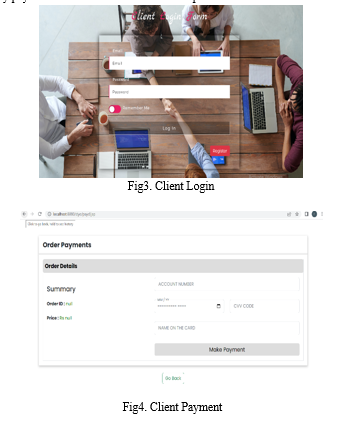
B. Module 2: Admin
In this module admin want to login to the admin page, it will redirect to the admin homepage. In the Admin homepage the menu can include company info, lab report, upload data, requirement data menus displayed on the admin homepage. The admin will verify the company details. Once the registration details are verified then admin will generate the id for the client through the email process after that only the admin approve the client to the further process otherwise admin won’t allow client to proceed for further process. Admin get the upload details of client then send the uploaded details to analyzer and view the lab report in the admin module so, admin is responsible for approve the process, reject the process, or to give suggestion. Here the admin will update the payment details to the client for the processed data. The administrator will review the payment information after receiving payment from the user. If the payment is verified successfully then the client will generate a report to the client.
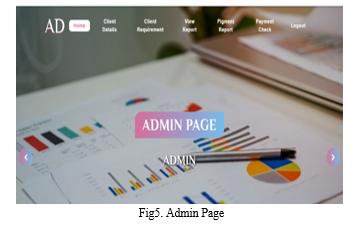
C. Module 3: Industry
In this module manufacturing team need to log in to the industry page in this module, which will then redirect to the industry home page. The view requirement, view analyzer report, and update details menus are located on this homepage. After successfully logging in, the manufacturer see the client's requirements in detail and view the report generated by the analyzer. If everything is accurate, the admin will examine the register information after registration is complete and authorize the industry. Otherwise, it won't permit you to proceed. The industry can view the registration details on a view details page and industry can also view the analyzer report in the analyzer report page. After that the industry will implement the process based on the client requirements and produce the sample for the client requirement. Once the sample is successfully prepared, it will send to the testing process for testing the sample which is created under certain ratios. The industry will update the status report to the admin page.
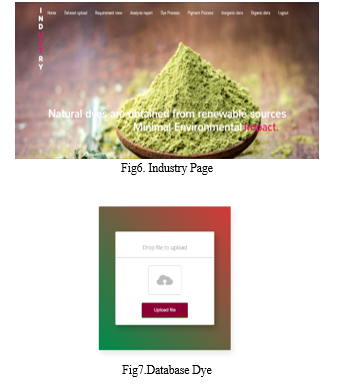
D. Module 4: Analyzer
In this module, analyzer need to log in to the analyzer page, it will redirect to the analyzer page. In this homepage the menu can include requirement view, upload report, requirement upload displayed on the analyzer homepage. After successful login the analyzer will able to access data on this page and also can view the client requirement details send by the admin in the view requirement page. Once the analyzer has reviewed the demand, it will compare the client's provided requirements with the industry's uploaded data to determine whether possible to produce or not. In this module analyze the data using logistic regression algorithm is one of the widely used algorithm comes under the machine learning algorithm. Logistic regression algorithm it will predict the output of a categorical dependent variable. Therefore, the outcome must be categorical or discrete value here the prediction also done using the logistic algorithm. After the process the analyzer will send the report to the client and also send report to industry how to apply their requirements.
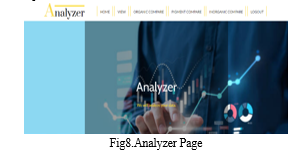
E. Module 5: Lab
In this module the lab technician need to login to the lab page, it will redirect to the lab homepage which has request data, view sample, check data, report view are the menus displayed on the lab homepage. After login successfully the lab technician will access the data. Technician request the sample details from the industry to test the sample. After that get the sample from the industry lab technician will test the sample using the perfect process uploaded by the lab technician. Check the sample using the proper process uploaded by the technician and the sample produced by the industry. After comparing the two data we will get the proper output from the laboratory if everything is accurate the lab technician will approve the process which is manufacture under the correct PH ratio, heating temperature etc. Then the lab technician will then upload the report to the admin.

Conclusion
The current work provides an overview of contemporary research and opinions on a few natural pigments and dyes. A few of the most important properties of colorants, as well as their chemical composition and manufacturing, are covered in the discussion. There is also a description of the specifics of the dyeing method and the future outlook. Good substrate performance, commercial viability, and biodegradability are requirements for a desired colorant. It would be ideal to carry out more research and refine the process for producing colorants from natural resources. India has a large supply of plants, minerals, and animals that generate color. Therefore, by enhancing their processing, in future which leads to a great production may achieve. Consider looking into bacterial and insect-based colorant production. The use of natural mordant will be researched to improve the performance of colorants.
References
[1] Y. He, B. Wu, D. Wu, E. Beyazit, S. Chen, and X. Wu, “Online learning from capricious data streams: A generative approach,” in Proc. 28th Int. Joint Conf. Artif. Intell., Aug. 2019, pp. 2491–2497. [2] B.-J. Hou, Y.-H. Yan, P. Zhao, and Z.-H. Zhou, “Storage fit learning with feature evolvable streams,” 2020, arXiv:2007.11280. [Online]. Available: https://arxiv.org/abs/2007.11280 [3] C. C. Aggarwal, J. Han, J. Wang, and P. S. Yu, “A framework for ondemand classification of evolving data streams,” IEEE Trans. Knowl. Data Eng., vol. 18, no. 5, pp. 577–589, May 2006. [4] N. C. Oza, “Online bagging and boosting,” in Proc. IEEE Int. Conf. Syst., Man Cybern., Oct. 2005, pp. 2340–2345. [5] H. Wang, W. Fan, P. S. Yu, and J. Han, “Mining concept-drifting data streams using ensemble classifiers,” in Proc. 9th ACM SIGKDD Int. Conf. Knowl. Discovery Data Mining (KDD), 2003, pp. 226–235. [6] H. Nguyen, Y. Woon, W. K. Ng, and L. Wan, “Heterogeneous ensemble for feature drifts in data streams,” in Proc. 16th Pacific-Asia Conf. Knowl. Discovery Data Mining, 2012, pp. 1–12. [7] S. C. Hoi, J. Wang, and P. Zhao, “LIBOL: A library for online learning algorithms,” J. Mach. Learn. Res., vol. 15, no. 1, pp. 495–499, 2014. [8] S.-Y. Li, Y. Jiang, and Z.-H. Zhou, “Partial multi-view clustering,” in Proc. 28th AAAI Conf. Artif. Intell., 2014, pp. 1968–1974. [9] Muslea, S. Minton, and C. Knoblock, “Active+ semi-supervised learning= robust multi-view learning,” in Proc. 19th Int. Conf. Mach. Learn., 2002, pp. 435–442. [10] C. Xu, D. Tao, and C. Xu, “A survey on multi-view learning,” 2013, arXiv:1304.5634. [Online]. Available: http://arxiv.org/abs/1304.5634 [11] S. J. Pan and Q. Yang, “A survey on transfer learning,” IEEE Trans. Knowl. Data Eng., vol. 22, no. 10, pp. 1345–1359, Oct. 2010. [12] R. Raina, A. Battle, H. Lee, B. Packer, and A. Y. Ng, “Self-taught learning: Transfer learning from unlabeled data,” in Proc. 24th Int. Conf. Mach. Learn. (ICML), 2007, pp. 759–766.
Copyright
Copyright © 2023 V. Mohana Priya, U. Ruchitha, Mrs. S. P. Audline Beena, Dr. D. Rajinigirinath. This is an open access article distributed under the Creative Commons Attribution License, which permits unrestricted use, distribution, and reproduction in any medium, provided the original work is properly cited.

Download Paper
Paper Id : IJRASET51923
Publish Date : 2023-05-10
ISSN : 2321-9653
Publisher Name : IJRASET
DOI Link : Click Here
 Submit Paper Online
Submit Paper Online

